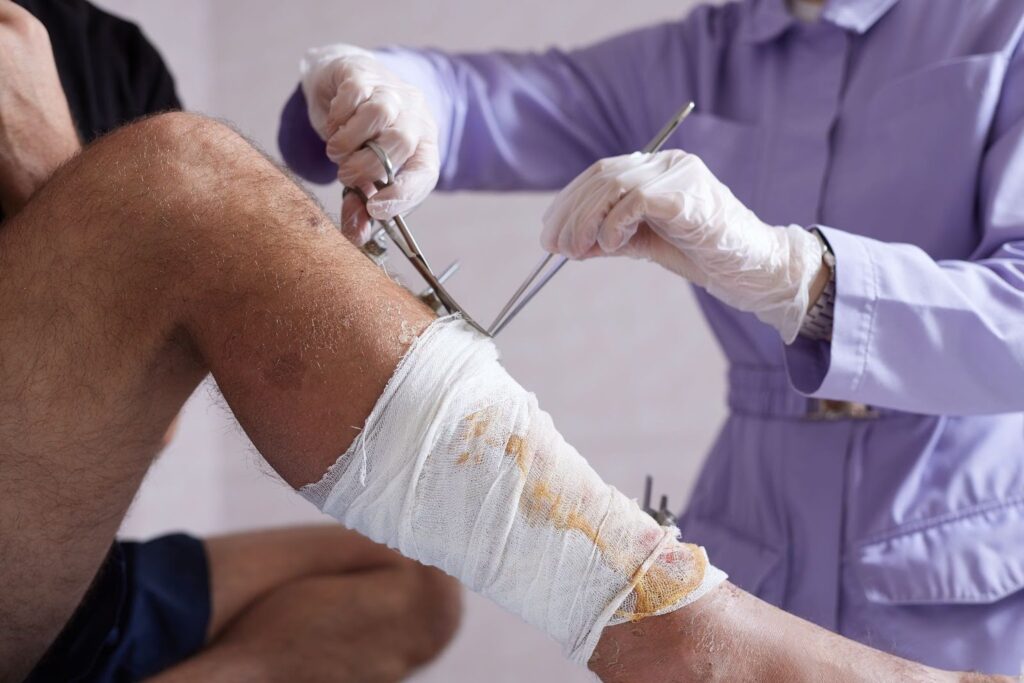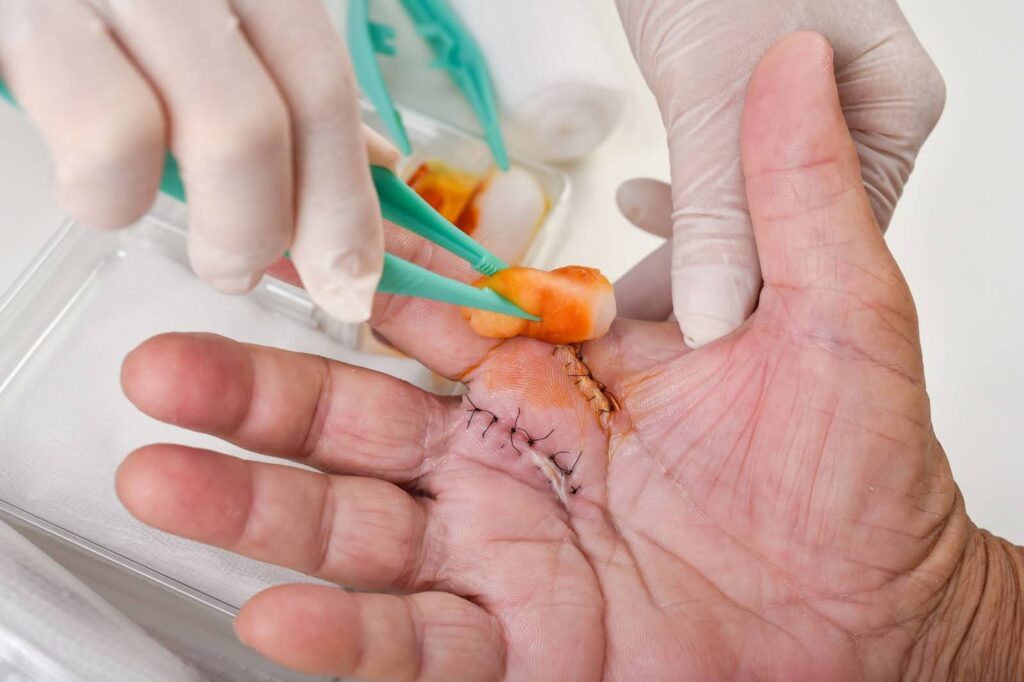
The Role of Debridement in Healing an Undermining Wound
An undermining wound can leave people feeling confused, even helpless. It often appears smaller on the outside than it truly is on the inside. As it spreads beneath healthy skin, the damage worsens quietly and dangerously. Many people struggle to understand why their wounds won’t heal, despite appearing clean on the surface. Knowing what’s happening beneath the skin and how proper care, such as debridement, can restore the body’s healing power is vital to moving forward.
Understanding an Undermining Wound
An undermining wound doesn’t always appear threatening at first glance. The surface may seem shallow or dry, while deeper tissue destruction continues to expand. This wound spreads beneath intact skin, forming hollowed-out areas or tunnels. Due to this hidden damage, treating it like a regular wound is ineffective. Patients often need professional help to assess and manage it properly
What is an Undermining Wound?
An undermining wound spreads under intact skin, forming hidden pockets beneath the wound edges. It’s usually caused by pressure, trauma, or poor circulation, and most often appears in areas like the hips or buttocks. These wounds differ from surface injuries because the visible part is smaller than the internal damage. Clinicians detect undermining using a cotton swab to trace how far the tissue loss extends under the skin. Left unchecked, this wound slows healing and creates the perfect space for infection to thrive.
Why They Don’t Heal Like Normal Wounds
Wounds that resist healing often do so because the surface can close while deeper tissue remains damaged. That leads to an illusion of progress that masks ongoing internal decay. Poor circulation inside the cavity limits the oxygen and nutrients needed for repair. The body’s immune system struggles to reach these hidden areas, letting infection take hold. Without exposing and treating the full extent of the wound, healing stays out of reach.
Why Debridement Matters in an Undermining Wound
Undermining wounds don’t respond to surface-level treatments alone. The deeper cavities trap dead tissue, bacteria, and other harmful debris. That’s where debridement becomes necessary; it removes the obstacles that hinder healing. By clearing out the dead weight, the body regains its ability to repair and regenerate tissue.
What Debridement Actually Does
Debridement removes dead or infected tissue from a wound, helping to restart the healing process. It uncovers the proper depth and size of undermining, clearing space for healthy tissue to form. By eliminating barriers, debridement improves blood flow, reduces the risk of infection, and enhances the effectiveness of other treatments. It gives the body a clean slate to build new cells. Without it, even the best wound care can fail.
Signs That Debridement is Needed
Common signs that a wound needs debridement include foul odors, slough or black tissue, and a lack of visible healing. If the skin around the wound softens or peels back, or tunneling is suspected, deeper tissue damage may occur. These red flags show that the body can’t move forward independently. Undermining wounds, especially, need attention since damage often goes unnoticed. Removing dead tissue helps break the cycle of decay and deterioration.
Types of Debridement for an Undermining Wound
Each type of debridement offers a distinct approach to addressing wound complexity. Some work faster, while others offer more comfort or control. The choice depends on the patient’s needs, wound stage, and available resources. Understanding the differences helps individuals make more informed decisions with their care team.

Surgical Debridement
Surgical debridement utilizes specialized tools, such as scalpels, to remove damaged tissue quickly and precisely. It’s ideal for extensive or deep undermining wounds that need immediate cleaning. The procedure is performed in a sterile setting and may involve anesthesia, depending on the depth of the procedure. Afterward, the wound is dressed and monitored during the post-surgical healing period to ensure a clean recovery and optimal tissue repair. This approach offers a rapid and controlled method for preventing chronic deterioration.
Enzymatic Debridement
Enzymatic debridement uses prescription ointments to dissolve dead tissue without harming healthy cells. It’s slower than surgery, but ideal for people with poor circulation or those who avoid invasive procedures. The treatment requires daily application and regular assessment to track progress. It’s effective for moderate undermining wounds that need gradual tissue breakdown. When used consistently, it can uncover and treat hidden areas.
Autolytic Debridement
Autolytic debridement relies on the body’s enzymes, supported by moisture-retaining dressings, to soften and remove dead tissue. It’s gentle and low-pain, making it suitable for patients with a low tolerance for discomfort. However, it works slowly and needs close monitoring to prevent infection. It is best suited for shallow or stable undermining wounds. As dead tissue lifts, new growth can take hold.
Mechanical Debridement
Mechanical debridement uses physical methods like irrigation or wet-to-dry dressings to remove damaged tissue. While effective for some surface wounds, it can harm healthy cells and cause discomfort. Undermining wounds must be used cautiously to avoid worsening the damage. It’s often a supporting method rather than a standalone treatment. Its value depends on the wound’s location, depth, and response.
How Debridement Helps Heal an Undermining Wound
Healing begins when the roadblocks inside the wound are removed. Dead tissue, bacteria, and trapped fluids hold back the body’s natural repair system. Debridement clears the way and sets the stage for healthy growth. It also enhances the response to antibiotics, provides pressure relief, and improves the effectiveness of other treatments.
Creates a Clean Base for Growth
Debridement clears out dead material, allowing oxygen and nutrients to reach living cells and fuel tissue growth. A clean wound bed provides a stable surface for healing cells to build upon. New tissue can’t stick or grow properly without removing what doesn’t belong. Blood flow and cell activity improve once the wound is free of obstructions. This reset lets the body restart the repair process effectively.
Reduces Bacteria and Biofilm
Dead tissue creates a breeding ground for bacteria, which form protective biofilms that resist antibiotics. Debridement disrupts these biofilms, exposing harmful microbes and making treatments more effective. It lowers infection risks and improves wound hygiene. Reducing the bacterial load also minimizes odor, drainage, and swelling. Clean wounds support better immune responses and faster progress.

Supports Other Treatments
Once the wound is cleaned, dressings, antibiotics, and other treatments become more effective. Medications can reach the damaged areas more easily, and dressings adhere better, retaining moisture. Pressure-relief techniques also work more efficiently without dead tissue in the way. This support is essential for undermining wounds because of the hidden structure. Debridement helps other interventions work more effectively.
Risks of Delayed or Incomplete Debridement
When an undermining wound isn’t fully cleared, healing stalls. Incomplete debridement leaves dangerous tissue in place. The damage can spread quietly under the skin. Some patients are unaware of the extent until major complications arise. Proactive care changes that story.
Deeper Tissue Destruction
When undermining wounds aren’t fully cleared, tissue destruction continues under the surface. What begins as minor erosion can expand into muscle or even bone. Delayed action allows decay to spread silently, making future treatment more painful and complex. The wound becomes more complicated to assess and more challenging to treat. Timely removal of dead tissue keeps damage from going deeper.
Increased Pain and Recovery Time
As infection and inflammation progress, pain intensifies, and movement becomes increasingly difficult. Dead tissue causes pressure and swelling that make the area sensitive. Healing also slows down, prolonging the recovery process. Debridement helps relieve pain by removing the source of irritation. With the wound reset, healing can proceed with less discomfort.
Possibility of Amputation or Sepsis
If bacteria spread unchecked, the infection can reach bones or enter the bloodstream, causing sepsis. It puts organs at risk and may become life-threatening. In advanced cases, removing the affected limb may be the only way to stop the spread. These outcomes are more likely when dead tissue remains in place. Proper debridement helps prevent the chain reaction from escalating.
How Specialists Help Heal an Undermining Wound
Wound care specialists bring more than tools; they bring judgment and skill. They know how to evaluate complex wounds and create real solutions. Their involvement often changes the course of healing. With deep wounds like undermining ones, their input is essential.
Proper Assessment and Planning
Wound care specialists examine the depth, width, and complexity of the undermining wound. They use tools to detect hidden pockets and plan targeted treatments. Their assessments guide the type of debridement needed and adjust as healing progresses. Each wound requires a customized strategy based on its unique behavior, and specialists provide that precision.
Hands-On Debridement Techniques
Specialists use sterile tools and skilled techniques to remove damaged tissue safely. They manage pain, bleeding, and exposure risks during the process. If deeper pockets are found, they adjust the approach immediately. They know precisely what tissue to remove and what to leave. This precision helps the wound heal more quickly and safely.
Patient Education and Ongoing Care
Wound care professionals also teach patients how to care for their wounds at home. They explain how to clean, dress, and monitor the site for changes. This guidance prevents setbacks and encourages consistency. They also advise on the correct wound care supplies, ensuring that dressings and tools support healing rather than hinder it. Patients feel more confident and involved in their healing, and regular support helps them stay on track.
Stop an Undermining Wound From Getting Worse
Waiting to treat an undermining wound gives it time to grow. What appears to be a minor problem today could quickly escalate under the surface. The longer dead tissue sits in place, the more it blocks healing. Debridement provides your body with what it needs to restart the recovery process. If you notice slow healing, hidden damage, or foul smells, don’t delay—reach out to a wound care provider who understands what lies beneath the surface.
Discover more expert insights on wound care at the Stem Health Plus LLC blog. Your next step to informed healing starts here.
